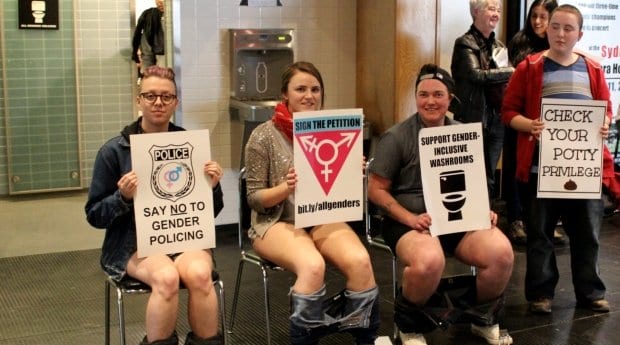Students and faculty staged a “shit-in” at Simon Fraser University Feb 18, occupying a men’s washroom in the Academic Quadrangle to raise awareness about transphobia on campus.
Approximately 50 people participated, says Nathan Lyndsay, a third-year gender, sexuality and women’s studies student and one of the event organizers. Students were handed flyers as they walked past or used the bathroom.
Co-organizer Theron Meyer, a third-year student in the same department who uses the gender-neutral pronoun “they,” says they feel “unrecognized and unaccommodated” on campus. Meyer chooses not to endure the stares or comments they receive when using the gendered bathrooms currently available, instead opting to use single-occupancy washrooms that are far away from their classrooms.
With a lack of gender-inclusive bathrooms, trans and gender-non-conforming students, staff and faculty at SFU say they don’t have a safe place to go. To deal with that, people do what they can not to go to the bathroom and get sick as a result, says Lucas Crawford, a lecturer in gender, sexuality and women’s studies at SFU. “How a campus is designed and how it represents itself shows who is welcome and who is not,” Crawford says.
Chair Willeen Keough says the department’s entire faculty attended the shit-in to show their support.
Tim Rahilly, the associate vice-president of students at SFU, says he’s surprised the shit-in was held.
“Back in 2003, we did a lot of work with students on this issue and we identified the single-occupancy washrooms and the washrooms designated for accessibility,” Rahilly says. “At that time, we started working on the signage to ensure that wherever possible we would have washrooms accessible to everyone.”
Rahilly says some on-campus residences also have gender-inclusive washrooms, with private showers and toilets and a common sink area. Female-only floors are for students who self-identify as female, he adds, and are trans inclusive.
Lyndsay says the university sent out a release that states there are 82 gender-inclusive washrooms on campus. “The washrooms that they are describing are the accessible washrooms, which have a graphic of a man in pants and a woman in a skirt, and that’s still reinforcing the gender binary,” Lyndsay points out.
An online petition addressed to Rahilly asks SFU to convert some of its multistall washrooms and all of its single-stall washrooms to be gender-inclusive and to commit to integrating gender-inclusive washrooms in plans for any new buildings.
“If we just put up the signs, then people will use the washrooms,” Keough says. “Our washrooms need to be redone anyway.”


 Why you can trust Xtra
Why you can trust Xtra


